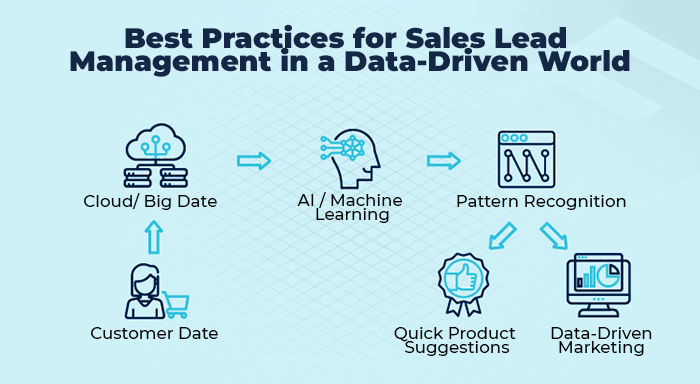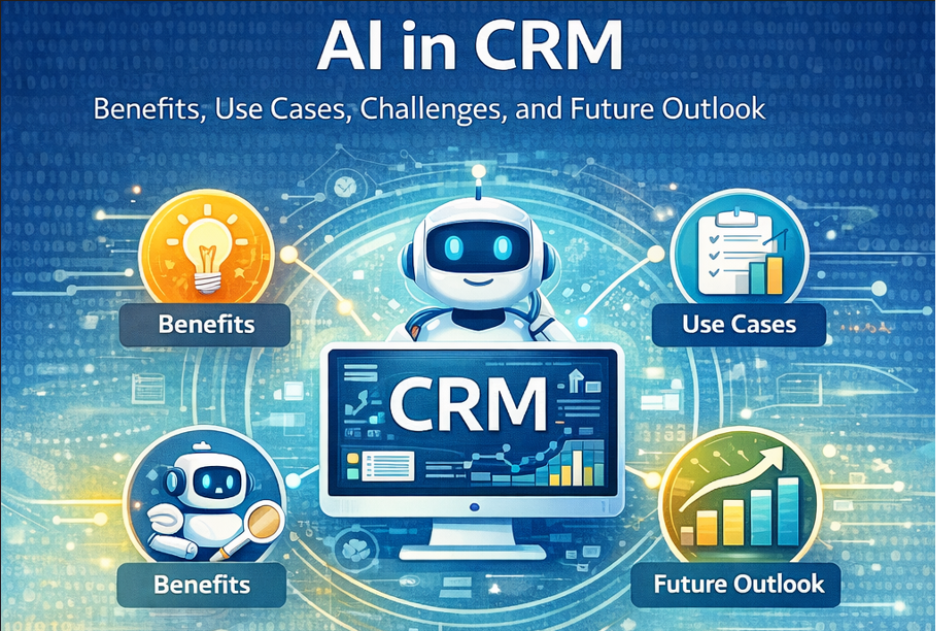Lead generation and conversion are challenging for any sales professional or business owner. As the trends of Modern business are becoming dynamic day by day, hence you need to find out the tools as well as strategies that can address the issues and rectify them together.
Accordingly, more sales organizations are realizing how game-changing data can be in their thinking about their systems, processes, and goals. When your organization becomes more capable of gathering and interpreting data, it’s easier to prioritize your outreach, optimize your sales pipeline, and make revenue growth more predictable and repeatable.
So, there’s one big question: How do you ensure you’re collecting the right data?
Why data is Crucial for Sales Lead Management
Sales success comes from smart decision-making. You have to understand your target audience intimately, and depending on gut feelings or your instincts about how your product will fit a given market’s needs can be a big risk.
Having the right data on hand makes a huge difference here. As you can start to identify patterns and better understand what your customers need, what they want, and how your product can make their lives easier, developing messaging and lead-generation campaigns that attract them is much easier.
With the right campaigns, you’ll surface the right leads. And when you surface those leads, you can take the next best steps.
With accurate and required data, you can make informed decisions about sales and prioritize leads. You can also focus your efforts on activities with the highest potential for success. When you don’t use data consistently to inform your decisions, you make guesses and hunches, and neither serves you long-term.
Using accurate data as a springboard for thoughtful decision-making conserves your team’s resources and amplifies your chances of closing deals and achieving your sales goals.
How to Optimize Data Collection and Analysis Efforts Toward the Right Data
Understanding the importance of data in sales lead management is just the beginning. The next step is to employ strategies to collect and analyze the right data. Analyzing data on lead behavior will help you decide where to focus your outreach and tailor your approach to each lead's unique needs and preferences. Platforms like Trestle make this process more seamless by helping businesses validate and enrich their lead data, ensuring that every insight you act on is accurate and up to date.
These are the four ways that can assist you in getting the most out of your data collection and analysis efforts:
- Lead scoring: This method involves assigning a score to each lead based on their behavior and engagement with your brand.
- Once you focus on leads with the highest score, so you can easily optimize your outreach efforts and level up your chances of success.
- Tracking key performance indicators (KPIs): Monitoring metrics such as conversion rates and sales velocity will help you identify areas for improvement and make data-driven decisions to improve your overall sales process.
- Combining quantitative and qualitative data: To get a more holistic overview of your sales lead management processes, it’s essential to use a mix of measurable quantitative data from sources like website and email analytics, as well as more subjective and thorough qualitative data through other customer service methods like your live chat function.
- Predictive analytics for sales forecasting: Using the rich data set you’ve already gained from your historical and current sales, predictive analytics can help you forecast future sales to more accurately plan your pipeline and allocate resources accordingly.
Strategies for Implementing a Data-Driven Sales Approach
Having a reservoir of data is one thing, but harnessing it effectively is another. To do this, you need to establish a data-driven culture among your sales group and have to choose the right tools and technology to work on the right track.
Beyond that, high performance needs to be rewarded so your sales team stays bought in and understands that using data as the backbone of their decision-making process will likely lead to additional rewards down the road.
Let’s examine these strategies more closely:
1. Establish a Data-Driven Culture within your Sales Team
If you want to avoid information silos between your sales and operational teams, it's important to establish a data-driven culture within the business. This culture should encourage your sales reps to collect, analyze, and regularly share data across teams.
Data-driven cultures are extremely valuable, as they help the wider business make smarter decisions. As you do this, then you will be updated that everyone is working on the same page and making efforts towards the same goals, which increases motivation and general morale.
2. Choose the Right Tools and Technology
To support a data-driven business culture, the next step is to choose the right tools and technology. For example, this might include selecting a CRM that can integrate a robust scheduling system, like Calendar Hero, to collect and analyze data to suit your business goals. You can also look at marketing automation software and lead-scoring tools with advanced analytics. Incorporating features like a multi-step form can further enhance data collection by guiding users through a structured process, ensuring more detailed and accurate information.
A smart way teams are improving sales is the use of AI-supercharged sales pods—small, agile sales teams powered by AI that streamline prospecting, personalize outreach, and help your team to stay focused on high-value activities.
3. Regularly Track and Review Performance
Finally, you must regularly track and review your performance to ensure your data-driven sales strategy works effectively. This means monitoring relevant KPIs and using this data to make informed decisions about optimizing your sales pipeline.
To ensure you're on the right track, identify your sales goals and choose metrics aligning with those objectives. A note, however – it’s important to measure only needle-moving activities. Don’t stress that every single thing your salesperson does needs measuring. Some activities are still important to build a robust pipeline that isn’t easily attributable or measurable.
Stick with the basics.
For example, suppose your goal is to increase the number of new sales appointments scheduled. In that case, you can measure metrics like click-through rates on different scheduling links in strategic places, open rates for email marketing campaigns, or the number of new leads generated from social media.
Another important step is to implement regular performance reviews. This will assist you in tracking the progress of your team members and refining your tools and strategies. For example, if you notice an email campaign isn’t working as expected, you might check if your domain is blacklisted or review your email open rates to see how effective your outreach efforts are.
Following these steps, you can identify the areas in which you need to make improvements. Moreover, you can optimize your strategy for success and can stay one step ahead of your competitors.
Challenges That Commonly Appear on Using Data in Sales Lead Management
As everyone knows, data is a powerful tool for sales lead management, but you also need to know the other pitfalls. This is because there are many other pitfalls than data that may prevent you from achieving your desired results.
As we have covered the significance of data in sales lead management and how to utilize it effectively by prioritizing leads and optimizing sales pipeline, Hence, let me walk you through some hurdles you could face whenever your team moves forward to prioritizing a data-driven approach.
Relationship-Building
Although data is helpful, it can't replace the need to build trust with others. Relying too heavily on data can lead to neglecting the significance of building personal relationships with your prospects and present customers.
As you will prioritize the data of your customers over relationships, you may miss out on opportunities to connect with people on a deeper level. So, you need to make sure that you are balancing the use of data with the cultivation of personal relationships altogether.
Analysis Paralysis
With countless metrics and analytics that might be measured, it's easy for teams to become overwhelmed and suffer from analysis paralysis after spending hours in meetings sifting through data, trying to make sense of it all.
Data overload quickly sets in, in this scenario. There’s so much data on hand that you don’t know where to begin analyzing it. And, unfortunately, plenty of man hours can get wasted in the process if you start going down the wrong path.
For betterment, you need to avoid data overload and make informed decisions by setting clear goals, and prioritizing them. Plus, by focusing on the most important data, and using tools and techniques to streamline your analysis process.
Misinterpreted or Misunderstood Data
As we said earlier, your success depends on smart decision-making, and it’s difficult to make smart decisions with inaccurate information. Therefore, rushing through the analysis process can have serious consequences, negatively affecting your success.
In case, you get the data wrong consequently you may make poor choices, so it's important to take the time to study well and understand the information before driving any conclusions. Thereby, you need to make sure that your decisions are based on accurate and reliable data, that will ultimately lead to better outcomes.
Conclusion
Data is crucial for sales lead management in today's business world. By using data to prioritize leads and optimize your sales pipeline, you can make smarter decisions that lead to increased sales success.
However, your sales team must manually use data and sales strategy to enhance human relationships. As you will implement the good practices for a data-driven sales strategy, most of the data will automatically be maintained with the personal touch with your customers.
While data-driven sales lead management offers numerous advantages, integrating it into your existing sales processes might not be straightforward. Along with this, transitioning toward a more analytical approach demands careful planning, preparation, and an understanding of the potential roadblocks.
The Human Element in Data-Driven Sales
While data provides clarity and direction, the human element remains irreplaceable in sales. Building genuine relationships, understanding subtle nuances in client communication, and being empathetic are traits no amount of data can replicate. The challenge is in striking a balance: leveraging data for strategic insights while esnuring that the human touch remains central to your sales efforts.
Empathy, for instance, cannot be quantified. While data might indicate a lead’s buying behavior, only a human can truly understand the motivations and emotions behind those decisions. Sales reps should be trained to use data as a tool to supplement their interactions, not replace them.
Quality Over Quantity in Data Collection
In our enthusiasm to become data-driven, there’s a risk of collecting excessive data—much of which might not be directly relevant. It’s crucial to prioritize quality over quantity. Rather than hoarding extensive data, focus on specific collections, relevant requirements, and actionable insights. This not only makes the analysis more manageable but also ensures that the insights derived are directly beneficial to your sales process.
Training and Skill Development
Transitioning to a data-driven approach requires upskilling your sales team. Not all sales professionals are comfortable with data analytics, so regular training sessions are essential. This training should cover the basics of data interpretation, using analytical tools, and integrating data insights into the sales process.
Additionally, it might be beneficial to have periodic workshops where the sales team can discuss their experiences, challenges, and successes in leveraging data for decision making. This fosters a cultureof continuous learning and adaptation.
Data Privacy and Security
In a world where everyone is concering about data privacy, it’s paramount to ensure that the data you collect is secure as well as compliant with all relevant regulations. This not only safeguards your business against potential legal issues but also builds trust with your clients and leads.
Furthermore, always be transparent about the data you collect and its intended use. This can be communicated through clear privacy policies and direct communication channels.
Integration with Existing Systems
For a more effective data-driven sales strategy, you need to integrate with your existing systems, such as your CRM, sales platforms, and communication tools. This might require investing in new technology or adjusting your current tools.
In conclusion, while the transition to a data-driven sales strategy might come with challenges, the rewards in terms of improved sales efficiency, better lead prioritization, and more informed decision-making are well worth the effort.
You need to remember that data is a tool to enhance human interactions, not replace them. Hence, with the right balance, businesses can harness the power of data while ensuring that the personal touch, which is the essence of sales, remains intact.
Related Posts:
Ultimate Statistical Analysis tools for handling your business data
A Guide On Using Startup Data for Better Data-Driven Investment Choices



